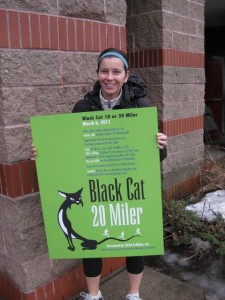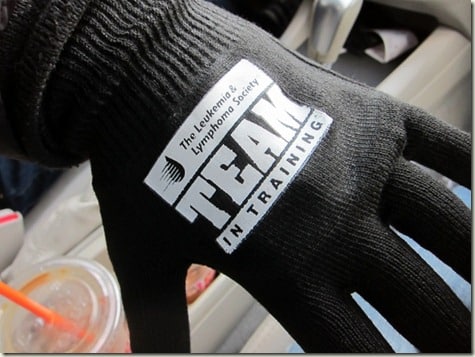Today’s guest post is from a new to me blogger, Laura, who happens to be one of my only runner friends who has been published in Runner’s World! How cool is that? This gal crushed 50 marathons before the age of 25 and has since gone on to become a pacer for multiple marathons and one of Athleta’s Power of She sponsored athletes! I hope you enjoy learning a thing or two from Laura during today’s Marathons+Moderation installment!
 As a frequent marathoner, people often ask me how I find the time – not just to run the races, but to train. They often assumed that when I was pushing for my 50 state challenge (I ran a marathon in all 50 states in two years), I must have made running my full-time job. Far from it! I work in strategy consulting, and work anywhere from 50-80 hours a week. Furthermore, because my job demands that I be on site at my client (whether they’re in Texas or Virginia), my schedule never constant – so I can’t get into the kind of regular routine that many people believe is necessary to run a marathon. I want to let people know that despite all those things working against me, I still did it – and you can too. Here are my top tips:
As a frequent marathoner, people often ask me how I find the time – not just to run the races, but to train. They often assumed that when I was pushing for my 50 state challenge (I ran a marathon in all 50 states in two years), I must have made running my full-time job. Far from it! I work in strategy consulting, and work anywhere from 50-80 hours a week. Furthermore, because my job demands that I be on site at my client (whether they’re in Texas or Virginia), my schedule never constant – so I can’t get into the kind of regular routine that many people believe is necessary to run a marathon. I want to let people know that despite all those things working against me, I still did it – and you can too. Here are my top tips:

Finding a time to run
I have always been a big fan of morning rather than evening running. In the morning, you can set your alarm and get your workout done before anybody or anything else has a chance to get in your way. Morning workouts put you in a great mood for the rest of the day – it feels great to know that while most people were just getting out of bed, you were getting in a workout and making more progress toward accomplishing your goal. Plus, if you’re running outside, I just think it’s so much prettier and peaceful and in the morning than in the evening – especially if you live in a big city. As a Manhattan resident, I’m used to all kinds of craziness on the streets in the evening, but I love going for a run at 8am on a weekend and finding the streets so empty that I could practically run down the middle of them. Morning running just puts me in a good mood!
If you try morning running and still don’t love it, that’s totally fine – you have to do what works for you. If you get nothing else out of my post, I hope you take away that marathon training is all about flexibility. Don’t let some silly schedule or anyone’s rules on the "right" way to train stress you out. Just like your body has to get used to running for 4+ hours at a stretch, your marathon training plan has to evolve and adapt to your lifestyle. Heck, I didn’t even have a "training plan" for my first marathon, aside from always going for a long run on the weekend! It didn’t matter – it was what worked for me. Besides – a flexible approach will not only help you to avoid overstressing your mind, but it will also help you to prevent injuries, since you’ll be listening to your body instead of some silly calendar.

Finding a place to run
I spend a lot of time in unfamiliar cities, where it’s not that easy to go on a "usual" running route. Instead of looking at a new location as a challenge, look at it as an opportunity to try new places and new terrain. Incorporate some principles of Parkour into your run: if you come to a bridge, go over it; if you come to a hill, go up it. Sometimes when you know the area, you unconsciously plan your running routes to avoid a challenge, so resolving to stick to your path can actually be a great way to mix up your workout and prepare for a marathon course that you’ve never run before.
One of the great things about running is that you can just take off and go. If you’re really good with directions (I’m lucky enough to have that skill), use your run to explore the city – just make sure to ask your hotel concierge about any parts you may want to avoid for safety reasons. If you’re directionally-challenged, find a main road that has a sidewalk and go for a nice out-and-back… and maybe bring a cell phone, your hotel address, and cab money in case you do get lost 🙂
For a more structured approach to finding a route, you can always try Googling running routes in that city… or better yet, try to find a running blogger in the area. The running blogger community has introduced me to people from all over the country, and since they tend to write about where they run, I’ve heard about some pretty neat routes. When I got staffed on a project in Boston, one of the first things I got excited about was the chance to run along the Charles River, since I had read many Boston-area bloggers’ reports of doing just that. If you don’t know of any running bloggers in the city you’re visiting, a quick Google search can remedy that – and help you find blogs you might never have heard of. To learn the ropes, you can even email the bloggers you find and invite them to go on a run – they’ll probably have all kinds of insight about the city and things to point out along the route, and as a bonus, you may make a new friend.

When you can’t get out and run
Maybe you’re in an area where it just isn’t safe to go for a run, especially if you only have early morning and late night times available. Personally, I hate the treadmill, so that just doesn’t work for me as an option. Instead, cross-train! I think many runners overestimate how much actual running they need to prepare for a marathon, compared to just time being on your feet and breaking a sweat. For my first marathon, I logged a lot of hours on the elliptical – which had the added bonus of being lower impact than straight-up running.
I always planned for a long run on weekends, when I knew for sure that I’d be home and could plan my schedule around my runs (vs everything that always comes up on weeknights). I found that one long run a week was enough to get my legs into shape for a marathon, and supplemented my long runs with activities like weight training (to strengthen my leg muscles) and cardio (to work on my endurance and willpower). Marathoning is so much about the mental training and the persistence, so doing something like 2 hours on a boring elliptical will definitely help you prepare for that 🙂
Don’t forget the mental training
I have done many marathons where I’ve gone in completely undertrained (oops), and finished with some pretty remarkable times given the circumstances – and I believe it’s due to the mental component of marathoning. Spend at least some of your "training time" figuring out mental tricks to get you through the tough times – sitting on a plane waiting for takeoff is a great time for this kind of planning!
For example, I have always loved listening to music while I run with Airdrives headphones that simultaneously allow you to hear everything around you – it’s incredibly dangerous and dumb to wear regular headphones while running. For my first marathon, I sent out a Facebook message to all of my friends and asked them to send me an mp3 file of a song that would remind me of them or would otherwise inspire me. I then made a playlist of all the songs I got, titling each song with the name of the person who sent it to me. When my motivation waned, I would look at my iPod and be encouraged, knowing that person was supporting me and cheering me on from afar. I think the fastest mile of my race was mile 17, when my best friend’s selection of "If you’re going through hell, keep on going!" came on 🙂

Finally, relax
Whether you’re traveling or not, life is always going to get in the way of your marathon training – and you have to be ready to accept that. Maybe your alarm clock doesn’t go off one morning, and you oversleep and miss your only chance to work out that day. Maybe you plan for an evening workout but then at 7pm your boss asks for another report… by 8am tomorrow. That’s okay! Again, I feel very strongly that the one long run on weekends is enough to prepare you for a marathon – so during the week, you just need to do the best you can.













